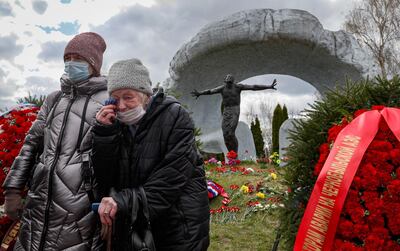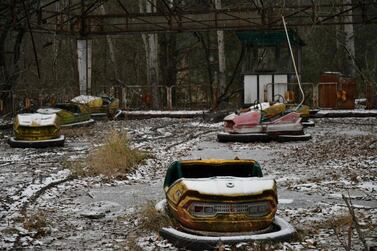Scientists have discovered a safer way to analyse dangerous radioactive materials that could help in the clean-up operation at the Chernobyl site 35 years on from its nuclear disaster.
Engineers from the University of Sheffield in northern England say they have successfully used ultra-bright X-rays to identify the material in a simulation.
The nuclear accident in northern Ukraine on April 26, 1986 left the area contaminated and uninhabitable and could take an estimated 24,000 years before it is safe.
Radioactive materials were mixed with fuel cladding and other building materials in the reactors and are now incredibly difficult and dangerous to remove from the site.

But if left untreated, the Lava-like Fuel Containing Materials will pose an ongoing radiological safety risk to the environment.
At Chernobyl, the mixture of molten fuel, cladding, steel, concrete and sand formed nearly 100 tonnes of highly radioactive lava, which flowed through the nuclear power plant and solidified into large masses.
Very few samples of the meltdown materials are available to study and the masses are often too hazardous for people or even robots to approach in order to better understand them.
But the scientists managed to recreate LFCMs for the first time after research published in the Journal of Materials Chemistry A.
"This is such a big breakthrough because it opens up a world of possibilities to develop a deeper understanding of some of the most dangerous materials that still remain in Chernobyl," the report's lead author Dr Claire Corkhill told the Yorkshire Post.
“These hazardous materials are so dangerous that until now, nobody has been able to analyse them in great detail and this is hampering efforts to decommission the site. Our study has found a safe way of doing this.”
The scientists used two of the world’s brightest microscopes called X-ray synchrotrons in Switzerland and the US as part of their research.
The X-rays were able to identify small samples of uranium allowing scientists to create a 2D chemical image to reconstruct the events that occurred immediately after the Chernobyl incident.
“Like a forensic analysis of a crime scene, the chemical analysis performed on our simulant materials allowed us to piece together the last moments of the Chernobyl nuclear fuel as it melted together with other components in the reactor to form a volcanic-like lava," she said.
"Our analyses are consistent with the limited data available on real samples, which is extremely exciting."
Dr Corkhill said understanding the properties of LFCMs was critical in the mission to create radiation-resistant robots to remove the hazardous material, not only in Ukraine but also in Japan, where a nuclear explosion took place in March 2011 at Fukushima.
“The major difficulty in understanding the real materials is that they are too hazardous to handle and, although the Chernobyl accident happened almost 35 years ago, we still know very little about these truly unique nuclear materials.
“Thanks to this research, we now have a much lower radioactivity simulant meltdown material to investigate, which is safe for our collaborators in the Ukraine to research without the need for radiation shielding. Ultimately, this will help advance the decommissioning operations at Chernobyl and at Fukushima, too.
“Since the clean-up of Chernobyl is anticipated to take around 100 years, and Fukushima at least 50, anything we can do to speed up the process will be beneficial to Ukraine and Japan, in both financial and safety terms.”
The explosion in the fourth reactor at Chernobyl led to the creation of an exclusion zone the size of Luxembourg in Ukraine and neighbouring Belarus.
Authorities say it may not be safe for humans to live in the exclusion zone for another 24,000 years. Meanwhile, it has become a haven for wildlife with elk and deer roaming the forests.
Dozens of villages and towns populated by hundreds of thousands of people were abandoned after the disaster, yet more than 100 elderly people live in the area today, the last remnants of more than 1,000 people who moved back to the exclusion zone only months after the disaster.







